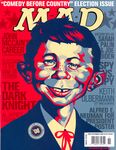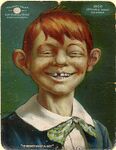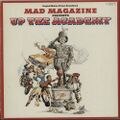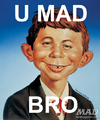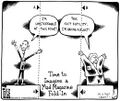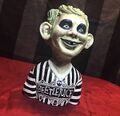MAD magazine: Difference between revisions
imported>The PolishPrince |
imported>Loldongs No edit summary |
||
| (6 intermediate revisions by 2 users not shown) | |||
| Line 169: | Line 169: | ||
File:MADvertising Camel.jpg|[[Joe Camel]] x MAD magazine | File:MADvertising Camel.jpg|[[Joe Camel]] x MAD magazine | ||
File:MAD Magazine 345 Class of 96 BTW You're Doomed.jpg | File:MAD Magazine 345 Class of 96 BTW You're Doomed.jpg | ||
File:AlfredENigga.jpg | |||
File:Number one ecch wiki dramatica.jpg|If ''MAD'' is "The Number One Ecch Magazine" - Then ED's the "Number One Ecch Wiki". | File:Number one ecch wiki dramatica.jpg|If ''MAD'' is "The Number One Ecch Magazine" - Then ED's the "Number One Ecch Wiki". | ||
</gallery>|border=#ED1B24|color=white}} | </gallery>|border=#ED1B24|color=white}} | ||
| Line 191: | Line 192: | ||
{{timeline|Featured article June 9 & 10, [[2018]]|[[Bad Webcomics Wiki]]|{{PAGENAME}}|[[Unikitty]]}} | {{timeline|Featured article June 9 & 10, [[2018]]|[[Bad Webcomics Wiki]]|{{PAGENAME}}|[[Unikitty]]}} | ||
{{timeline|Article of the Now April | {{timeline|Article of the Now April 11 & 12, [[2023]]|[[Raptor Jesus]]|{{PAGENAME}}|[[Batman]]}} | ||
Latest revision as of 02:14, 13 April 2023

MAD magazine is a "satirical" magazine which began as a comic book for EC Comics in 1952 and was written and edited by Brooklyn Jew Harvey Kurtzman, back when "comic book" meant funny paper rather than typical generic capeshit. The magazine's mascot, Alfred E. Neuman, himself a variant of an older "Me Worry?" meme, is one of the original "pre-Internet memes."
Some argue MAD magazine was the original redpill in the 1950s, setting the formula for all Amerifat satire that came after. Although, the "alt-right" may argue it was the original blue pill, as "a vehicle for Jews to spread degeneracy throughout society" which culminated in hippies and feminism and eventually the social justice warrior. MAD magazine promoted skepticism of everything, and influenced Harry Shearer, Terry Gilliam, Robert Crumb and all underground comix, Weird Al, even Roger "Jaws No More" Ebert. MAD magazine preceded Fark and Something Awful and 4chan by decades, until loaning its brand to a TV show that had barely a damned thing to do with it.
In 2017, it was announced that the longtime New York staff ("The Usual Gang of Idiots") of MAD magazine was going to be replaced with a brand new staff from California. Also, in 2018, the magazine relaunched its numbering with a brand-new #1 and plans for a "increased web presence and a new podcast" - thus, the reason for this article.
Recurring features
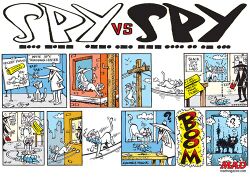
As with most magazines MAD has several trademark features that appear in every issue of the rag - in addition to the occasional new ideas.
- Drawn-Out Dramas/Marginals - One of the longest running MAD features that hasn't been replaced by new writers or artists, these are extremely tiny drawings that appear in-between the margins of the articles. Drawn by Sergio Aragones.
- A MAD Look At... Another Sergio Aragones features, wordless comic strips with a topical focus... i.e: "A MAD Look AT Wonder Woman," A MAD Look At Picnics," "A MAD Look At Harassment" . It's been running regularly since the early 1960s.
- The Darker Side of The Lighter Side - A rehash of an older feature by the late artist Dave Berg - more reprints - but Berg's highly optimistic and conservative cartoons are printed TWICE with the second one being a new rewrite. Possibly discontinued as of the new/rebooted MAD.
- The Lighter Side - Similar to "A MAD Look At..." and created by artist Dave Berg, this feature has been recently resurrected with a new artist for the relaunched MAD magazine..
- Potrzebie Comics - New to the rebooted (in 2018) MAD magazine run, this is a somewhat medium length section of the magazine that features various comic strip serials. Replaced the comic strips section feature from New York/Original MAD magazine's run that was called "The Strip Club".
- The MAD Fold-In - A one-page cartoon/gag that when folded in, gives a new drawing and answers a question. Drawn by longtime MAD artist Al Jaffee, this feature doesn't have much longer to go as Al Jaffee is ONE HUNDRED ONE YEARS OLD... but like the Spy vs. Spy feature, the big corporate honchos at DC will likely also replace the artist with a new one when they die.
- MAD Movie Parody/TV Show Parody - Each issue usually features a "parody" of a popular show or movie, with all character names changed to goofy names, and a twist ending for each one. This feature is probably what MAD is best known for, as well as a big factor in their sales - latching onto pop culture is an easy way to snatch coins it seems!!
- The Wisenheim Museum - "Iconic" illustrators/artists pay tribute to MAD magazine via their art in this monthly feature. Basically replaces "The Gap-Toothed Gallery," a feature which was added near the end of the New York Run/Original Run of MAD.
- Alfred E. Neuman For President: Alfred E. Neuman For President is a running gag that has occurred every 4 years since 1956 and targets disillusioned USA voters to "write in" Alfred E. Neuman as their choice for USA Presidential Candidate.
- The MAD Vault - As most of the original/"classic" MAD artists/writers are DED, or are retired, MAD has in recent years decided to reprint their work in each issue in a feature called "The MAD Vault." Probably intended as a way to fill space in the magazine. Discontinued as of the MAD mag relaunched/rebooted run.
- Spy vs. Spy - See below section, a Cold War satire comic-strip that's outlived the Cold War by decades.
Spy vs. Spy

Spy vs. Spy is the greatest thing that ever happened to Americunt comics and was created by Cuban refugee Antonio Prohías when he was fleeing Castro's Murder Corps, in May of 1960, on a truck tire's inner-tube with only a single pack of ramen noodles to eat. His inspiration for the comic came from how Castro once honored him for his Anti-Batista comics but then later accused him of being a spy and working for American capitalists and the CIA when Prohías published works in 1959 that criticized Castro's stranglehold and censorship of the Cuban press.
Being a natural go-getter and committed to his work, Prohías was unlike the modern Millennial artist-type that sleeps all day, lives in their mother's basement and e-whores for donations because they are working on something so groundbreaking they need to invest every second to their art. Needing to eat and pay for a place to live Prohías took the standard entry-level jobs for non-English speakers such as a gardener and fast food employee while working on a new portfolio to submit to MAD magazine at night.
Prohías modeled the Spies that are familiarly drawn as two black and white characters in overcoats, pointy noses and wide brimmed hats after a character named 'El Hombre Siniestro' or 'The Sinister Man' that he had earlier created while a comic artist in Cuba.
Prohías once described the spies as "two sick fucks that thought nothing of smashing in the heads of puppies with a hammer or cutting the legs off of little girls so they can't get away from the men that they sold them to." Many people, or your average stoned college level philosophy major would say that this quote is the central theme behind Prohías' allegorization of the Cold War in Spy vs. Spy and the lines that governments are willing to cross with their Secret Wars that were going on during the Cold War and are still going on today.
Over the years Spy vs. Spy has been whored out and adapted for other medias such as a video game for the NES in the 1980s, Mountain Dew commercials, animated segments for both MAD TV shows, a board game and, worse yet, a kiddie cartoon for the now defunct MAD Kids magazine where, instead of trying to kill each other, the spies play practical jokes on each other ensuring that Prohías will be rolling in his grave for a long time over the bastardization of a comic that originally started as a protest against the unchecked going-ons of governments.
RIP Antonio Prohías: January 17, 1921 – February 24, 1998
Alfred E. Neuman
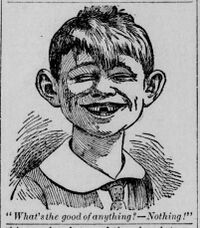
MAD's longtime mascot Alfred E. Neuman is, as mentioned earlier, one of the original pre-Internet memes, with cartoonists drawing him as nearly anything they want to make fun of. The gist of the character is that he's an idiot, with most covers depicting a famous celebrity as him. Surprisingly, MAD has been able to run this joke into the ground for over 60 years, with no one noticing that they're basically beating a dead horse.
What most people don't realize, however, is that Alfred is not even an original MAD creation. In fact, MAD was hit with a lolsuit in the 1960s by a money-hungry widow who claimed her husband had copyrighted a picture of Alfred back in the late 1910s. MAD only won the lawsuit after showing that there were pictures of Alfred dating back to 1902. Later researchers have found pictures dating back to the 1890s, meaning in addition to being a proverbial "dead horse" - the original human that Alfred was based on passed away years ago.
Similar to "Deez Nuts 2016," MAD's mascot has been a joke candidate for nearly every USA presidential election since 1956. MAD has even profited off of these runs by selling campaign kits and pins.
|
MAD magazine: song writers and the creation of "Weird Al" Yankovic

In 1961, a cabal of evil song writers including Irving Berlin✡, Richard Rodgers✡ and Cole Porter filed a $25 million lawsuit against MAD magazine for copyright infringement claiming that their "Sing Along With MAD Magazine" infringed on their rights as creators by parodying their songs.
Like so many Deviant Tartlets, Berlin and others claimed that these songs were their original creations and because of this, they were the only ones allowed to make changes to, make fun of or parody them. Their goal was the wet dream of anyone on DA who ever played Internet attorney thinking that they can file a LOL suit and sue the Internets. The goal of Berlin and the other songwriters was to erase the idea of fair use and make it so that someone would have to get the creators permission of something before it could be criticized or mocked in any way.
In 1963 Judge Charles Metzner of U.S. District Court for the Southern District of New York taught these bitches how to play choke a bitch when he tossed their case out of court, setting a legal precedent that allowed people like "Weird Al" Yankovic and DeviantArtists to make a living with their recolors and 90° flips when he said: "No one can own a tempo or meter to a song. Songs have developed from either people parodying them or rewording them for artistic purposes or just for the lulz. Hell! 'The Star-Spangled Banner' originates from an old British drinking song about boozing and screwing."
Afterwhich: Nothing of value was lost.
(Sidenote: This eventually came full cirle with Yankovic guest-editing an issue, #533, of the magazine.)
Competition
The original MAD comic book was originally a runaway success, with at least ten different knockoff titles on the shelves in the early 50s. Due to their shit quality, none of them lasted more than a year!!
After MAD converted to a magazine format (to please the increasingly-needy creator Harvey Kurtzman) a new wave of MAD rip-offs or competitors sprang up, with only a few lasting more than two decades. The longest was the now-SJW hijacked brand of CRACKED magazine which managed to last more than forty years, outliving even the original publisher of MAD.
The competing magazines often used Alfred on their covers as well, once again cementing him as a meme.
RIP Nick Meglin


Nick Meglin (Nicholas Meglin) (July 30, 1935 – June 2, 2018), possibly best known as MAD Magazine's Tennis Editor and somewhat known as the characture of a man playing tennis in The Lighter Side Of, was an editor for MAD Magazine for close to 48 years amnd died July 30, 2018. He will be sorely missed by everyone along with the ED staff.
Although he was listed as a Contributing Editor by MAD, the totality of his bylines could be counted on both hands. Nick Meglin's contributed immensly to MAD Magazine working mostly behind the scenes and ensuring that Mad Magazine was ready for print.
Besides being an editor for MAD Magazine, Nick Meglin was also an art instructor at the School of Visual Arts in New York City. He also has published a series of books which include The Art of Humorous Illustration and Drawing From Within.
Up the Academy

Up the Academy is a half way decent MAD magazine movie that was directed by Robert Downey Jr.'s dad back in the day when Robert Downey Jr. still had two nostrils and his original liver.
Up the Academy served mostly a vehicle for Ralph Macchio and takes its cues from the late 1970s and early 1980s teen movie plots of the cool but misunderstood outsiders versus the establishment that has been seen in other such hits as Meatballs, Animal House and Caddy Shack.
Up the Academy follows a group of teenage boys in a military school that consists of a mob connected teen, a rich, kleptomaniac Jihad Joe, a nymphomaniac and the obligatory cool black dude as they rebel against the rules and oppression of the school they are in, look to get laid, party and take revenge on the sadistic dean/commanding officer of the school.
Unfortunately, people had high expectations for the movie because of the MAD magazine connection and when it came out it was not well received. Ron Leibman, probably the biggest name in that movie at the time it came out, had his name removed from the credits and there were even rumors of MAD magazine disavowing this monstrosity.. In fact, MAD later demanded that MAD be removed from the title along with the beginning and closing scenes with Alfred E. Neuman clipped from the movie in later showings.
Always the class act and showing that it can make fun of itself, MAD magazine satirized its own creation in a parody called "MAD Magazine Resents Throw Up the Academy."
-
Lobby card
-
The cover to the soundtrack LP
-
MAD magazine's own tongue-in-cheek movie satire of the Up the Academy film.
MAD gallery lol
-
"Average MAD mag reader."
-
Example of a "MAD fold-in"
-
Example of a MAD magazine TV parody
-
"We Are Not MAD"... well, no shit.
-
Literal scum
-
ok then
-
U MAD BRO
-
Rule 34...
-
There are...
-
... No exceptions.
-
"Proofreader wanted"
-
Old MAD mag website
-
Example of the recurring MAD mag feature "The Darker Side of The Lighter Side"
-
Joe Camel x MAD magazine
-
If MAD is "The Number One Ecch Magazine" - Then ED's the "Number One Ecch Wiki".
See also
- MADtv — Unrelated TV show which basically bought MAD's name just for the street cred.
- Cracked.com — An imitator of MAD which turned out to be their most successful rival.
- Charlie Hebdo — The MAD of France... at least once upon a time.
- Garbage Pail Kids - Numerous MAD artists (such as Tom Bunk) worked on the card series.
- Private Eye — The MAD of Britain... at least once upon a time.
External links

|
MAD magazine is part of a series on Visit the Sites Portal for complete coverage. |
|
MAD magazine is part of a series on Visit the Television Portal for complete coverage. |
| Featured article April 1 & 2, 2018 | ||
| Preceded by In the kitchen |
MAD magazine | Succeeded by Jeremy Corbyn |
| Featured article June 9 & 10, 2018 | ||
| Preceded by Bad Webcomics Wiki |
MAD magazine | Succeeded by Unikitty |
| Article of the Now April 11 & 12, 2023 | ||
| Preceded by Raptor Jesus |
MAD magazine | Succeeded by Batman |




